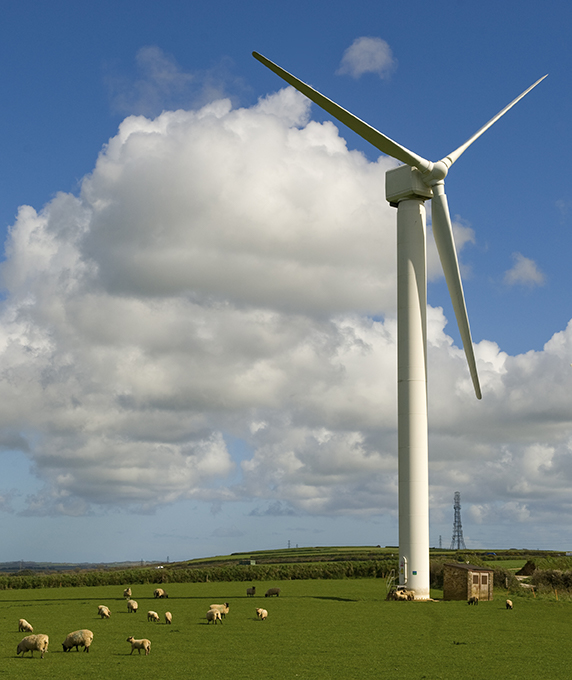Modern energy supply began as a private or local service of gas and electricity, largely based on coal in the early 20th Century. This grew to become national state-owned utilities, which was later unbundled to facilitate competition in generation and customer choice of supplier. The pattern of energy demand has shifted over the years reflecting economic growth throughout history as well as changing relative costs of different fuels, the perceived security of continued supplies and more recently, environmental considerations.
Pre-1900s
In the 18th Century peat was a main fuel in Ireland. The majority of industrial energy use was derived from small water and wind powered mills, the earliest of which dates to 1281. With the introduction of steam engines, the demand for coal grew.
Since Irish coal deposits were of poor quality, Ireland was highly reliant on coal imports. Once gas was manufactured through the carbonisation of coal by the early 19th Century, it was used for cooking, lighting and heating. Despite objections to underground pipes on grounds of noxious vapours and water contamination, gas lighting was introduced in 1824. By then there were three gasworks in Dublin; one operating from coal, one from fish oil and another from turf. The number of gasworks in Ireland grew to 114 by 1881 but their numbers dwindled with the growth of alternative modes of power.
Pre-1800
- -10500 Evidence of first humans in cave in County Clare.
- -4000 Start of forest clearance by Neolithic farmers.
- -3500 Ceide fields in Mayo cultivating wheat and barley.
- -3200 Newgrange passage tomb built.
- 1281 Earliest recorded windmill in Ireland in Kilscanlon, Co. Wexford. Used to grind grain.
- 1488 Ireland’s oldest company and the world’s oldest candle factory opened in Dublin – Rathbournes. Still in operation today.
- 1556 Start of Plantations. New settlers cleared forests for pasture and tillage.
- 1600 From an initial forest cover of around 80%, 12% remained in 1600.
- 1600 By the end of the 1500s turf was the main fuel in Ireland.
- 1638 Coal discovered in Leinster coal field. First shallow pit opens in 1638.
- 1650 Some 150 locations for smelting of iron ore recorded in Ireland. Huge demand for charcoal leads to more deforestation.
- 1684 Rev. John Clayton who later became Dean of Kildare demonstrated production of combustible gas from coal, referred to as the “spirit of the coal”.
- 1757 Construction of the Grand Canal from Dublin to the Shannon begins. The work was completed in 1804 and was used to transport passengers and goods between Dublin and rural Ireland.
- 1765 Coal discovered in Connaught coal field and was initially mined as fuel for iron smelting furnaces. Mining continued until 1990.


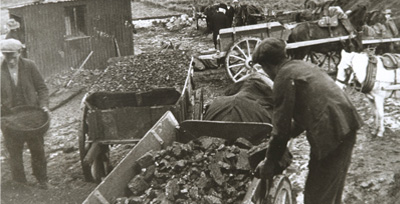
1800
- 1800 Only 2% of Ireland’s forests remain by 1800. Forest cover in Ireland remains below 2% until 1945
1810
- 1815 Charles Bianconi began a transportation network, transporting people around Ireland in stage coaches.
1820
- 1820 The Dublin Gas Company was established by a parliamentary act.
- 1822 Four gasworks in Ireland, producing gas mainly from coal. The early uses of coal-gas were largely confined to lighting, which replaced candle and oil power for public lighting.
- 1824 Despite objections to underground pipes on grounds of noxious vapours and water contamination, public street gas lighting was introduced.
- 1824 By this time there were three gasworks in Dublin; one operating from coal, one from fish-oil and another from turf.
- 1825 The first industrial scale harvesting of hand-won turf at Mona bog along the Shannon began.

1830
- 1834 Ireland’s first railway opens, running from Dublin to Kingstown (now Dun Laoghaire). It is the earliest dedicated commuter railway in the world.
1840
- 1840 By this time 250 windmills were operating in Ireland, usually located along the coast and used to mill grain and pump water.
- 1845 A public enterprise was set up in Dublin to distribute gas produced from coal.
- 1845 During the famine years the one of the only forms of heat for cooking and warmth was a peat fire. Where local pits existed, coal also protected the population from the worst ravages of the famine providing employment and fuel.
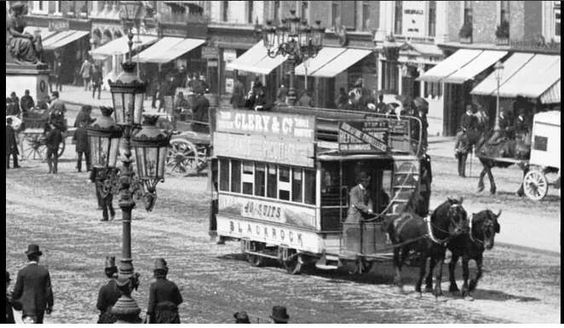
1850
- 1850 Colonel Kitchener, experimenting with the production of peat charcoal to manufacture gunpowder, discovered how to produce peat briquettes which have a higher heat output and longer burning time.
1880
- 1880 The first public electric light in Ireland was established at Prince’s Street in Dublin outside the offices of the Freeman’s Journal.
- 1881 By 1881 there were 114 gasworks operating in Ireland, the majority of which relied on coal for fuel. Gas was predominently used for lighting at this time.
- 1881 Land Act 1881 transferred vast areas of land to tenant farmers. Landowners cashed in forests before transfer as did new tenants.
1890
- 1892 Dublin Corporation opened its first electricity Power Station in Fleet Street.
- 1896 The first car is exhibited in Ireland.
- 1896 An electric tram was operated by the Dublin Southern District Tramways Company from Haddington Road to Dalkey.
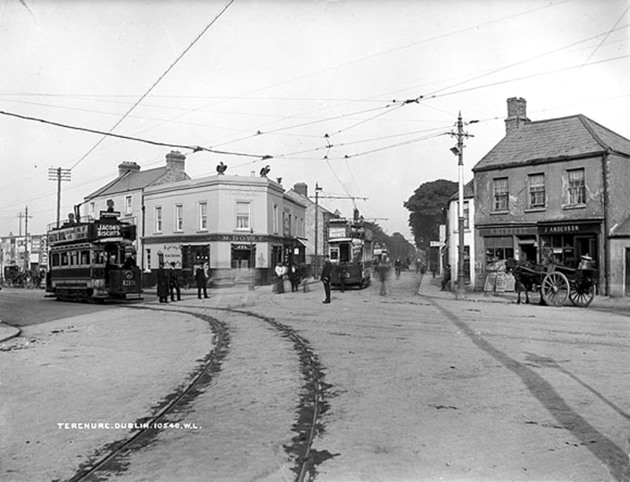
1900-1950
By 1906, 51 oil depots supplied oil to the rapidly growing Irish motor industry and sold paraffin for lighting to a population of 3.1 million. With the growing interest in electricity, a private act of parliament was passed in 1901 authorising the development of bogs in Leinster for electric power.
By 1925, hydro and wind power along with conventional coal, peat and gas were all being utilised to generate electricity, despite relatively low demand. Half of the population at this time worked in the agriculture sector and Ireland was unable to export much except for Guinness, Jacobs biscuits and agricultural produce. The social conditions often comprised of high density, poor quality housing, low wages, and an oversupply of labour. Following the civil war, Ireland had a declining population and the cost of the war – including rebuilding, compensation and financing the army – was 170% of the State’s annual income.
1927 – Electricity Supply Board established
The development of an electricity network in Ireland formally began with the passing of the Electricity Supply Bill in 1927. The Electricity Supply Board (ESB) was established to provide a safe, reliable and economic supply of electricity to the community. The first hydropower station was commissioned at Ardnacrusha in 1929 and other existing power stations were acquired. The fact that the output from the Shannon Scheme was twice the existing generating capacity in the state at the time indicates its relative magnitude. With the completion of the Shannon hydroelectric scheme only 85 gasworks remained due to the difficulties in importing coal after the war and the advance of state aided electricity.
The beginning of the electricity grid created the framework for the social, economic and industrial development of the country. Energy demand almost doubled during the 1930s; additional generation units were commissioned and the transmission network was expanded. Government policy intended to reduce unemployment and create an Irish industrial sector. A scheme to organise the production and sale of hand-won turf was established in 1934 and negotiations began to build a turf fired power station despite initial reservations about increasing costs and uncertainties of supply. Policy aimed to ensure that turf districts would be self-sufficient and that coal would only be used in non-turf areas. This changed with the advent of World War II in 1939.
1939 – World War II
As World War II continued coal quality deteriorated and difficulty in procuring coal resulted in the rationing of electricity. Stoppages of coal for domestic use led to greater reliance on gas. Soon gas was only available at reduced amounts for fixed hours. Petrol rationing was introduced as early as 1939 and the bulk of supplies which came from Britain were soon cut. Alcohol factories were bought and the government forced the oil companies to use alcohol for blending with motor spirit. By early 1942 policy favoured distillation of turf and aimed to secure and transport the maximum quantity of turf to Dublin at any cost. Stockpiles were laid down and briquettes, which had a higher calorific value, were allocated to priority industries such as bakeries, distilleries and railways. The establishment of Bord na Mona at this time made a significant contribution to both indigenous energy production, and industrial and socio-economic.
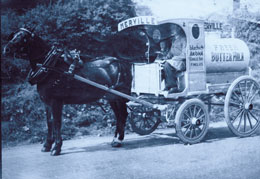
1900
- 1901 With the growing interest in electricity a private act of Parliament was passed in 1901 authorising the development of bogs in Leinster for electric power.
- 1902 Oil distribution depots for the distribution of lamp oil and kerosene are established at various strategic rail locations around the country.
- 1906 Around 51 depots around the country supplied oil to the rapidly growing Irish motor industry and sold paraffin for lighting.
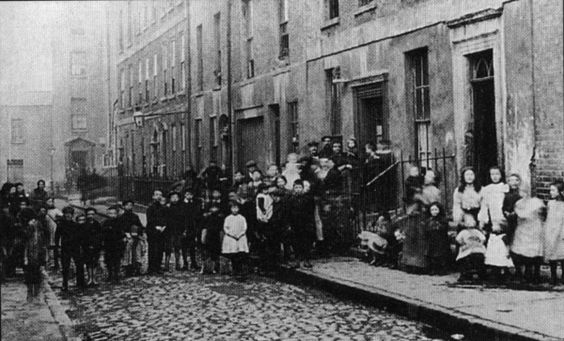
1910
- 1911 Peat is used to generate electricity in industry e.g. Hamilton Robbs linen factory or the Marconi wireless station.
- 1911 Housing patterns were very different from today; 22% of dwellings in Dublin were large homes and 36% were one room tenements. Nearly 10% of housing units had ten or more rooms.
- 1914 World War I (1914-1918). This impacted on Irish industry with restrictions on coal and higher transportation rates.
- 1916 Dublin port was a transit point for British goods and for the agricultural export trade. Cattle boats left at least seven times a day as part of 80 weekly sailings to England. The economy is dominated by agriculture (50% of workforce), linen production, shipbuilding, brewing and distilling. Ireland does not export much apart from Guinness, Jacobs biscuits and agricultural produce.
- 1916 Trams pulled by horses, horses, bicycles, and a small fleet of around 10,000 cars dominated transport. With the rise of electricity, it merited the end of the horse pulled tramcars.
- 1919 Alcock and Brown make the first non-stop crossing of the Atlantic by aeroplane, flying from Newfoundland and ending in Connemara bog.
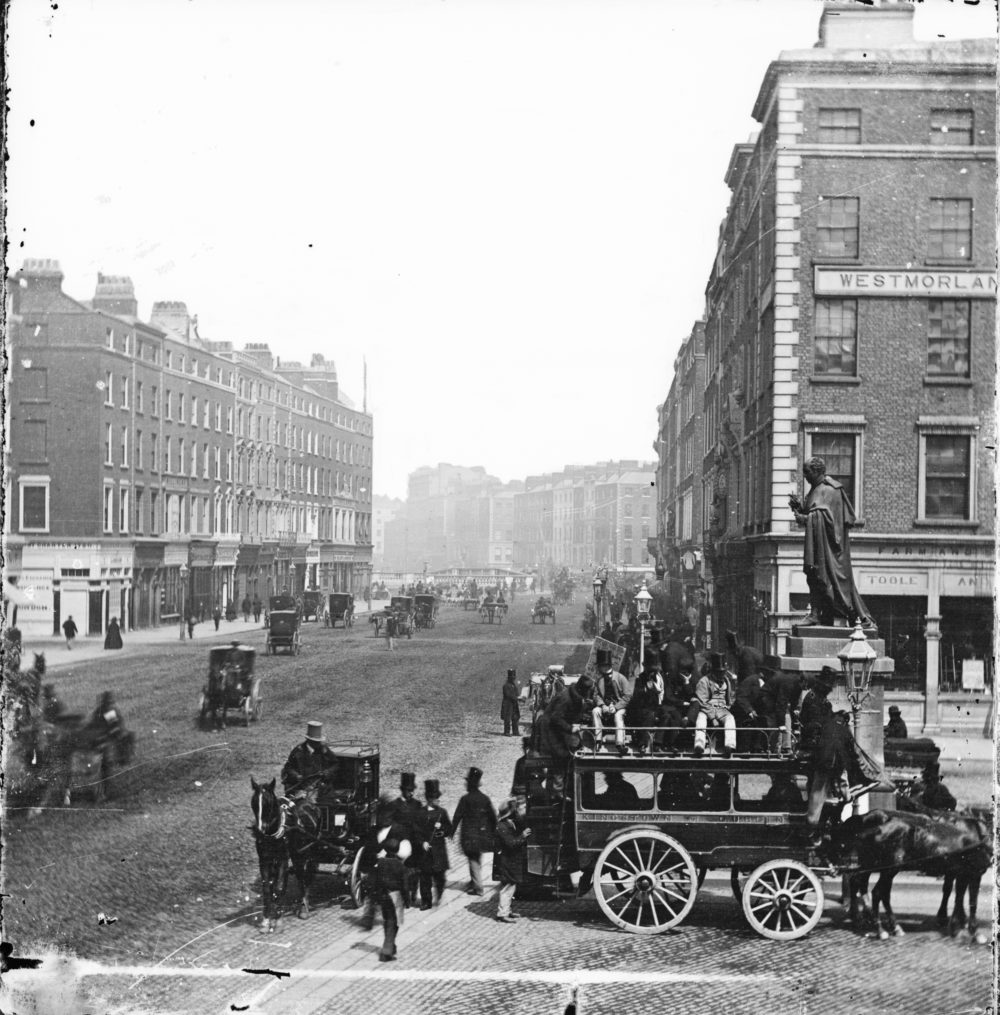
1920
- 1920 The first kerb-side petrol pump was introduced in Nassau Street in Dublin.
- 1921 A Commission of Enquiry into the Resources and Industries of Ireland estimated that Ireland used an estimated 4.7 million tonnes of coal and 6 million tonnes of peat.
- 1922 130 public electric supply schemes exist in Ireland, alongside a number of private undertakings.
- 1924 The output of gas had almost doubled from around 18,000 to 35,000 Gigajoules since 1904 because of urban development and expansion.
- 1925 The Shannon Electricity Bill was passed after acromonious debate to provide State electricity by means of hydraulic power derived from the waters of the Shannon.
- 1925 By this time hydro, coal, peat, gas and wind power were all being utilised in one form or another to generate electricity.
- 1927 The ESB (Electricity Supply Board) is established to provide a safe, reliable and economic supply of electricity to the community under the Electricity Supply Bill.
- 1929 Ireland’s first large-scale electricity hydropower station commissioned at Ardnacrusha, Co. Clare.
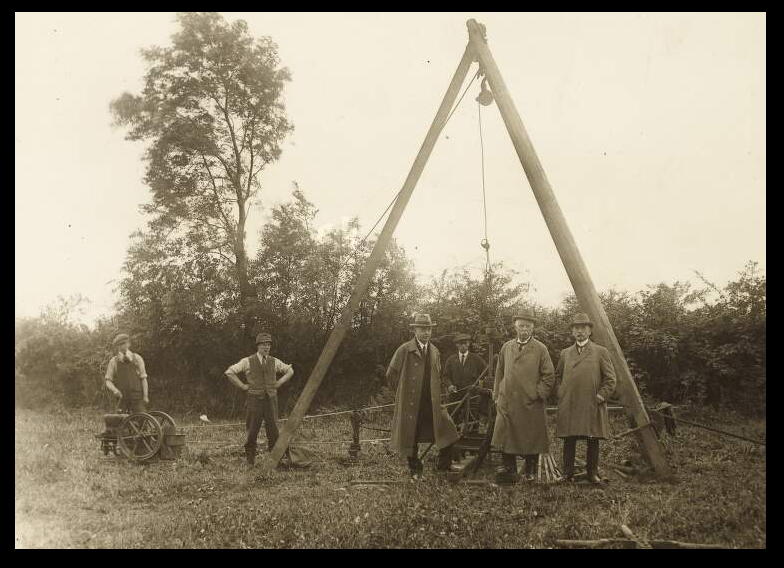
1930
- 1933 The first passenger air service from Ireland. Routes to Belfast and Liverpool are launched.
- 1933 The commissioning of another turbine marked the final development at the Ardnacrusha hydropower station.
- 1936 Aer Lingus operated the first Irish owned aviation service from Dublin to Bristol.
- 1936 The Government introduces a requirement that the oil companies purchase industrial alcohol made from surplus potato production for blending with motor spirit (Industrial Alcohol Bill), not dissimilar to the current biofuels obligation scheme.
- 1937 The construction of the River Liffey hydro-electric scheme (Pollaphuca, Golden Falls, Leixlip) begins, continuing into the 1940s.
- 1938 Double deck buses using internal combustion engines replaced electric powered trams in Dublin.
- 1939 World War II (1939-1945). Widespread rationing and shortage of fuel for industrial, domestic and transport use. Stoppages of coal for domestic use led to an immediate consumption of gas. Soon even gas was only available at reduced amounts for fixed hours of suply.
- 1939 New emergency orders made it a punishable offence to use gas in ‘off hours’ or to refuse entry to an authorised officer of the Dublin gas company (the glimmer man).
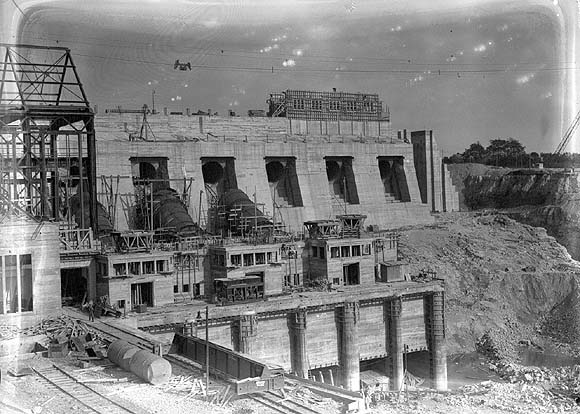

1940
- 1940 Dublin Airport officially opens.
- 1946 Bord na Mona are established as a peat development and supply utility.
- 1946 ESB’s Rural Electrification Scheme aims to deliver electricity to half a million homes facilitated by the post war upsurge in generation and transmission projects.
- 1946 662,654 private households around the country.
- 1948 Aer Lingus launched the first Irish trans-Atlantic aviation service.
- 1949 Over 15,000 new cars are registered.
- 1949 45.5 million gallons of oil imported.
- 1949 CIE operated most of the railway lines in the country, a total of 3675 miles of railway lines are open to traffic.
- 1949 17,000 flights go in and out of Dublin airport carrying 213,000 passengers.
1950-2000
1950 – Post WWII
The gas companies which survived the hardships of the war had to deal with high coal prices in the 1950s. The price of oil, on the other hand, fell in the years after the war to a point where it became competitive with coal. In 1949, 45.4 million gallons of oil were being imported for home use.
The post-war upsurge in demand led to the creation of the Rural Electrification Scheme from 1946 onwards. Under favourable hydro conditions it was possible to supply the unprecedented growth in demand in the first few years. The generation plant mix was supplemented by additional hydro, peat, indigenous coal and coal/oil units. While bad weather slowed peat production and virtually all machine turf was disposed of to the ESB and industry, a few years later, during the 1956 Suez Crisis, electricity rationing was avoided in part thanks to the ability of affordable peat-fired power stations to operate. At that time Ireland was dependent on petroleum for 39% of its energy needs in response to increasing demand for energy to underpin industrial, commercial, transport and societal activity. A consortium of oil companies established an oil refinery at Whitegate in 1958.
1960s
Peak demand exceeded 1,000 MW for the first time in the 1960s due to high growth in domestic and general heating, industrial development, and higher living standards in a population of 2.8 million. Interestingly, by 1966 over half the homes in Ireland had a TV set. The fruits of the First Programme for Economic Expansion of 1958 had begun to feed through to the Irish economy. Motoring became more popular for work, social and leisure activities, electricity demand grew, emigration slowed and the prospects for the future brightened as Ireland invested in its educational and economic infrastructure. In 1968, construction began on Turlough Hill, Ireland’s pumped hydro facility, as population grew and demand for electricity increased. Plans began for a north-south interconnector and new peat fired units were augmented with oil fired plants since oil was then a comparably cheap fuel.
1970s – energy crisis
The first oil crisis in 1973 followed by economic recession and a second oil crisis at the end of 1979 led to major fluctuations in the demand for electricity. The impact of the oil crisis on the cost of electricity was substantial as 2/3 of the total demand at the time relied on imported oil. The price gap between coal and oil sustained the demand for imported coal in the residential market and led to a revised appreciation of its value, hedging against risks to the security of the energy supply. Flexibility in ESB’s major contracts facilitated cutbacks in reaction to the recession, inflation and the oil crises. Peat still provided a valuable primary energy source, but proposals to increase peat were not sufficient, so pre-contract stages for a nuclear station began and a feasibility report was completed for an interconnector with Wales.
1970s – exploration, natural gas, and heating
Although the first oil and gas licence was granted in 1958, exploration was slowed by the depth of Irish waters off the West coast and the strong Atlantic weather. Between 1975 to 1985, 73 exploration wells were drilled, preceded by a fortunate discovery of the natural gas off Kinsale in 1971 with estimated reserves of £6 billion (1980s prices). It took two years to prove Kinsale gas field’s commerciality and three years after that in 1976 the gas was landed. Bord Gais Eireann was established in 1976 as a modern state-owned utility responsible for the purchase, sale, transmission and distribution of natural gas. A state owned fertiliser manufacturer and the ESB were the first to rely on this new source of energy. Flexibility to allow a range of primary energy sources was prioritised over the decade; an issue which became urgent due to the increasing oil prices and uncertainty about the continuity of supply. In addition, Ireland had joined the European Union in 1973 and began to interact with other countries in setting overarching sectoral policies. The introduction of thermal insulation standards for new homes in the late 1970s marked the first attempt to improve the energy performance of buildings in Ireland with solid fuels more popular as a means of heating than oil or gas.
1980s
The response to the second oil crisis of 1979 was more policy led with active participation in international strategy when making investment decisions. One of these was the construction of a new coal-fired power station at Moneypoint, County Clare (which went into commercial operation in 1986); aligning with the abandonment of a proposal to build a nuclear power station at Carnsore Point, County Wexford. Demand had decreased slightly due to the economic recession following the second oil crisis but by 1985 there was an improvement in public finances, production was rising and there were signs of sustained growth in employment due to competitive corporation taxes, greater access to third level education, and social partnerships between the government and trade unions. At the end of the 1980s the Ballycotton gas field was discovered, possibilities for wind and wave were being studied, and combustion turbines provided flexibility to meet fluctuating demand. However, this was still a difficult time for investment due to the long lead times, high capital costs of generation plants, uncertainties about the pace of economic growth, and the possibility of interconnection with external electricity networks.
1980s – heating and smog
In the heating sector, grants were introduced for the installation of solid fuels and central heating appliances. Within a decade however, what had been an energy crisis became a health issue in Dublin in particular with the regular occurrence of smog-like conditions on cold winter evenings in the capital. The Air Pollution act came into effect in 1990 with a ban on the sale and supply of bituminous fuels in the Dublin area. This was expanded to more areas as its effectiveness in reducing emissions became apparent. The banning of smoky coal opened up a new market for smokeless fuels and of these natural gas was by far the most competitive.
1990s – diversification, EU support and regulation
By the 1990s Ireland was heavily dependent on energy imports and the government looked towards expanding its energy portfolio. This saw, with EU support, the establishment of Ireland’s first wind-farm in 1992 at Bellacorick, County Mayo. This was a first step in the re-exploitation of Ireland’s wind resource and showed how cut over bog could be developed economically. EU support of Ireland’s energy policy was conditioned by the Commission’s awareness of the EU’s dependence on imports to meet its energy needs. While there was no provision in the Community Treaty for an energy policy, the EU recognised that it was in its long-term interest that one should evolve. In 1996 the EU adopted its first package of legislative measures aimed at liberalising the electricity and gas markets of the Member States. This marked the beginning of a major restructuring of the gas and electricity utilities in Ireland. The creation of the Commission for Energy Regulation through the Electricity Regulation Act in 1999 opened the market to competing suppliers. The building efficiency legislation was also strengthened and expanded to cover all new buildings and include provisions to such items as heating and lighting systems. Following some initial resistance, based on concerns about impacts on construction cost, the long term benefits and the capacity of the industry to adapt and innovate were recognised and energy efficiency has become an integral consideration in building design. The government also established a national energy conservation programme, which was initiated in 1994, to promote the reduction of waste and the more efficient use of energy across the economy.
1990s – gas
Gas prices in Ireland were affected by the Kuwait escalation of oil prices in 1990 and a decision to construct a gas pipeline to the UK was made. By 1994, BGE was serving 222,600 domestic customers and about 8,000 commercial and industrial customers. The ESB was its largest single customer, receiving 42% of all gas delivered. About a quarter of the fuel used in electricity generation in 1994 was indigenous natural gas. In 1996, Enterprise Oil announced the discovery of the Corrib Gas Field. Appraisal wells were also drilled off Cork and a small find was declared commercial in 2003. With indications that electricity demand would keep growing with the growth in the Irish economy in the 1990s, demand side management and investment in CHP and renewable energy aimed to reduce the requirement for new generation plant as well as reducing environmental emissions. A second gas pipeline to the UK was built in 2002.
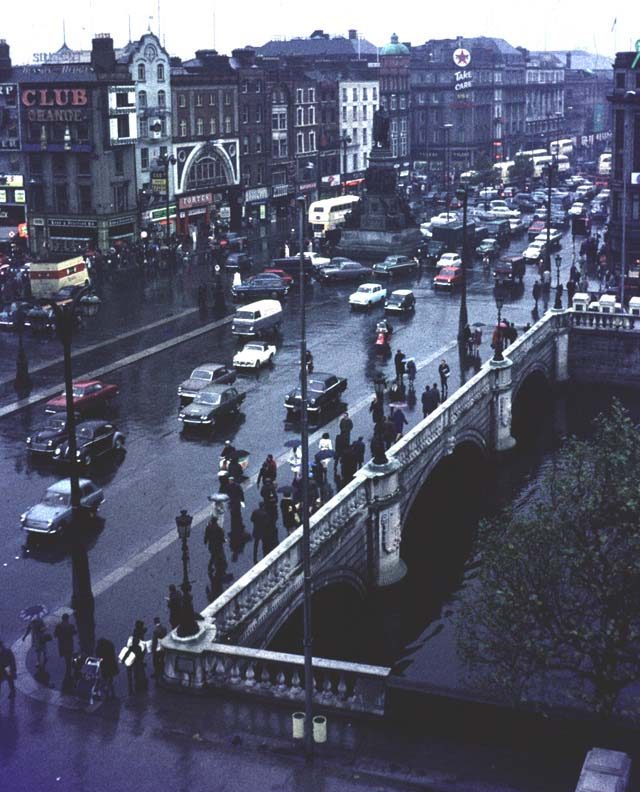
1950
- 1950 World prices of oil had fallen after the war to a point where it became competitive with coal for gas manufacture and power generation.
- 1950 High coal prices meant that those gas companies which had survived the hardships of the war moved away from coal carbonisation.
- 1950 First peat-fired generation station in Portarlington opens. Between 1950 and late 1960s, ESB installs over 400 MW of peat power plants.
- 1956 Electricity rationing may have been avoided after the Suez crisis in part due to peat fired power stations and their ability to operate with less expensive fuels than oil.
- 1956 As more peat fired stations came on stream supporting infrastructure was developed such as the first railway bridge to be built across the Shannon for 100 years.
- 1958 First exclusive licence to explore for oil and gas off Irish waters is granted to the Ambassador Oil Company for a nominal sum since so little was known about the potential for discoveries.
- 1958 A consortium of oil companies establishes the Republic’s first and only oil refinery at Whitegate.

1960
- 1960 Seven exceptional years of low peat yields during a decade of stable economic growth during which demand for electricity grew steadily.
- 1961 Ireland reaches a low point of population of 2.8 million people.
- 1967 The Six Day War led to a dramatic rise in oil prices, but prior planning adverted a major supply crisis in Ireland.
- 1968 Construction of Ireland’s only pumped hydroelectric storage station in Turlough Hill begins.
1970
- 1971 One of the exploration wells belonging to Marathon struck gas 27 miles off the old head of Kinsale. The total gas reserves of the Kinsale gas field at mid-80s price were valued at £6 billion.
- 1971 ESB completes large oil fired power station at Poolbeg in Dublin.
- 1972 The first UN Earth Summit takes place in Stockholm. It highlights global environmental challenges including energy sustainability and limited fossil fuels.
- 1973 Ireland joins the European Economic Community (now the European Union) – many energy Directives start to impact Ireland.
- 1973 The Yom Kippur War. Oil price rises from $2/barrel to $12/barrel.
- 1976 Kinsale gas is landed five years after discovery. The major users of the gas initially was a new fertiliser works at Marino Point and, some years later, the power station at Aghada, both located on Cork Harbour.
- 1976 Bord Gáis Eireann was established under the Gas Act of 1976, responsible for of the purchase, sale, transmission and distribution of natural gas throughout Ireland.
- 1977 Government grant scheme for installation of domestic solid fuel central heating.
- 1977 The ESB and the Government propose to build a nuclear power station at Carnsore Point, Co. Wexford.
- 1978 Residential and industrial conversion to use of natural gas fueled by Kinsale gas field, first in Cork and then in Dublin.
- 1979 Construction of a coal-fired power station at Moneypoint Co Clare began and plans for a nuclear power station at Carnsore Point, Co. Wexford are shelved.
- 1979 Second oil crisis occurs. With increasing oil prices and uncertainty about the continuity of supplies, the diversification of energy sources became an urgent issue. 2/3 of the total demand was produced from imported oil. International oil price rises from $14/barrel to $38/barrel.
- 1979 Energy Programme in the Institute for Industrial Research and Standards developed in response to the second oil crisis.
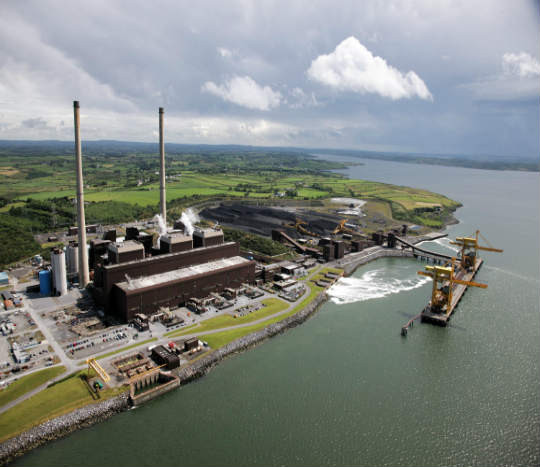
1980
- 1980 Financial crisis, temporary high oil prices creating an artificial market, price controls, the ageing of ESB peat fired power stations and the introduction of the private bog scheme.
- 1981 The dominant fuel for space heating was electricity.
- 1981 Several demonstration wind turbines installed by the Department of Energy in 13 projects around the country
- 1982 The conversion of the Cork gas system from town gas to direct use of natural gas commenced.
- 1982 The natural gas line from Cork to Dublin was completed and became the backbone of the national gas system.
- 1983 From 1975 to 1985 seventy-three petroleum and gas exploration wells were drilled in Irish waters and ports.
- 1985 World oil price collapses from $28/barrel to $14/barrel and generally stays below $20/barrel until 1999.
- 1987 Ireland’s single remaining coal fired power plant opens at Moneypoint as part of a fuel diversity strategy. At full output the station consumes approximately 7000 tonnes of coal per day.
- 1987 Many districts in urban cities found to be in breach of smoke and SO2 standards in winter, largely due to the open fire combustion of bituminous coal. The Air Pollution Act is transposed banning the sale and supply of smoky coal.
- 1988 First initiative in Ireland to tackle fuel poverty through energy efficiency actions.
- 1990 Building Regulations (including Part L – Conservation of Fuel & Energy) enacted.

1990
- 1992 The first wind farm comprising of 21 wind turbines in Bellacorrick, County Mayo comes online with an installed capacity of 6.45 MW, supported by the EU VALOREN programme.
- 1993 Bord Gáis build the first Irish sub-sea gas interconnector pipeline from Moffat in Southwest Scotland to Loughshinny in North County Dublin.
- 1994 Irish Energy Centre established with a promotional remit for energy efficiency and renewable energy.
- 1995 Highest ever rate of afforestation recorded at 23,710 hectares.
- 1995 Total peat production peaked at 8 million tonnes.
- 1997 United Nations Framework Convention on Climate Change publishes the Kyoto protocol.
- 1999 Electricity Regulation Act and Commission for Electricity Regulation (now Commission for Energy Regulation) established. Opening of electricity market to competing suppliers.
- 1999 Government Green Paper on Sustainable Energy published.
2000s
2000 onwards – renewable electricity
Onshore wind deployment was slow following the initial development, but accelerated after 2000 driven by international agreements; UNFCCC frameworks such as the Kyoto Protocol in 1997, as well as consolidated EU energy and environmental policy. Ireland’s own Nation Renewable Energy Action Plan (NREAP) led to the development of incentive schemes such as the Alternative Energy Requirement (1995 to 2005) and REFIT schemes (from 2006 onwards).
The initial AER was successful in terms of proposed projects but less so in terms of actual deployment, however the installed wind capacity increased to 744 MW at the end of 2006. With the REFIT scheme more renewable energy was added and by 2010 Ireland was producing almost 15% of its electricity from renewable sources. The construction of the interconnector with the UK assisted Ireland’s limited grid capacity and inconsistent domestic demand and renewable electricity supply. There is now around 2200MW of wind energy installed on the grid. Much of Ireland’s hydropower resource potential has already been tapped but opportunities remain for small scale decentralised generation. Historically, hydro was the largest contributor to renewable electricity in Ireland but with the rapid advent of wind it now only contributes to a small proportion of total electricity demand.
2000 onwards – peat
The Sustainable Energy Act of 2002 provided a legal framework for the operation of a public service obligation (PSO) for peat fired electricity generation. Three new generation stations – Edenderry, West Offaly and Lough Ree – were equipped with intermediate fuel stores which have a partial blending capacity. All three were affected by the carbon emissions trading regulations which came into operation in 2005/2006. Peat usage for electricity generation has declined since 1990, while the residential heating sector has moved away from solid fuel to natural gas and oil.
2000 onwards – environmental regulation
The renewed focus on environmental concerns regarding climate change since the 1990s is reflected in the development of legislation and plans to reduce emissions and improve energy efficiency: the Irish Energy Centre industrial energy efficiency programs; the Renewable Energy Strategy for the Future in 1996; the Sustainable Development Strategy for Ireland in 1997; the Biofuels Obligation Scheme in 2003; the development of the EU-Emissions Trading Scheme in 2005; the introduction of mandatory Building Energy Ratings from 2007; the first National Energy Efficiency Action Plan in 2009; the Renewable Energy Directive in 2009; National Renewable Energy Action Plan launched in 2010; and Part L of building regulations in 2011. New legislation was also introduced in 2011 to limit the maximum sulphur content of bituminous coal and increase the penalties for breaching the regulations. Moneypoint was refurbished to make it fit for purpose in terms of environmental regulations and standards. In 2013 it emitted over 3.4 million tonnes of CO2 into the atmosphere which is within the permitted amount under the EU-ETS.
2010
By 2010 the total Irish budget deficit stood at 120% of the GNP. The population of Ireland was 4.6 million and less than 5% of the workers were employed in the agricultural sector. The majority of homes were centrally heated, mainly by oil or gas. Energy demand in the transport sector has continued to increase, despite a short dip during the recession. Ireland was around 89% dependent on imported fuel in 2010, the majority of which was supplied to the transport sector.
2000
- 2000 Decrease in residential energy use since 1987 due in part to the switch from the use of solid fuels in open fires and back boilers to more efficient oil and natural gas central heating.
- 2001 Ireland’s fuel import dependency reaches 90%, and continues close to this level until 2014.
- 2002 Second interconnector gas pipeline built from Moffat in Southwest Scotland to Gormanstown in County Meath.
- 2002 Sustainable Energy Authority of Ireland (SEAI) established as a statutory authority under the Sustainable Energy Act. Delivers a range of energy efficiency, renewable energy and CHP programmes.
- 2002 90% of dwellings have central heating.
- 2002 Regulations Amending Part L of the Building Regulations 1992 come into force.
- 2004 Electricity generated from wind exceeded that from hydro for the first time.
- 2004 Tram services returned to Dublin with the opening of the Luas.
- 2004 The Census recorded 1,436,798 permanently occupied dwellings in the state, a 43% increase on 1990 levels.
- 2004 Ireland’s first solid biomass fuelled CHP plant begins operating producing heat for timber drying operations.
- 2004 Average dwelling consumed 24,500 kWh of energy. 79% was in the form of direct fossil fuels and the remainder as electricity (net consumption).
- 2005 Kyoto protocol enters into force as a legally binding document – EU committed to reduce its annual GHG emissions to 8% below 1990 levels by 2010. Ireland to limit its growth in annual emissions to 13% above 1990 levels.
- 2005 EU Emissions Trading Scheme established covering emissions from major power and heat generation facilities.
- 2006 Due to public and private afforestation programmes forest cover increases to 698,000 Ha (10.1%) in 2006. Up from 89,000 Ha in 1928 (1.2% land area) and 412,000 Ha in 1985 (5.9% land area).
- 2006 Final energy use in the transport sector grew by 167% since 1990.
- 2006 EU Energy Performance of Buildings Directive transposed into national legislation, including mandatory Building Energy Rating (BER) at the point of building sale or rental.
- 2006 EU Energy Services and Energy Efficiency Directives obliges Ireland to achieve energy savings of at least 20% by 2020 through energy efficiency.
- 2007 Installed wind capacity of 795 MW.
- 2007 All island Single Electricity Market established.
- 2007 Renewable Heat Deployment Programme and Combined Heat and Power Deployment Programme launched.
- 2008 Changes to the taxation of private cars to CO2 based system, together with obligations on car manufacturers to improve the efficiency of their new car fleets contributed to a change in the purchasing patterns of new cars.
- 2008 World oil price peaks at $145/barrel (nominal 2008 price).
- 2009 Renewable Energy Directive individually binding targets – 16% of energy from renewable sources by 2020 for Ireland. National targets of 40% renewable electricity, 10% renewable transport, and 12% renewable heat by 2020.
- 2009 Cycle to work scheme introduces tax relief for bicycles used for commuting to work.



2010
- 2010 Central heating systems fired by oil and gas in 80% homes in Ireland.
- 2010 Biofuel Obligation Scheme sets a target on average for 4.166% by volume of motor fuels to be produced by renewable sources.
- 2010 Carbon tax applied to road transport and extended to other fuel types.
- 2011 Population of Ireland is 4.6 million (an increase of 46% on 1911 levels).
- 2011 One municipal waste to energy plant in Ireland in County Meath. Renewable share of waste produces renewable electricity.
- 2011 Building Regulations Part L revised.
- 2011 Transport sector accounts for the most primary energy used in Ireland, followed by the residential sector.
- 2012 High gas prices and low coal and ETS prices resulted in more coal and peat being used for electricity generation.
- 2012 20% of Ireland’s electricity is produced from renewables, mainly wind.
- 2012 Move to diesel cars over petrol; the consumption of diesel increased by almost 230% and its overall market share grew from 33% in 1990 to 53%.
- 2013 Energy Performance in Buildings Directive superseded by recast Energy Performance Buildings Directive.
- 2013 Energy use in the transport sector was 97.5% dependent on oil products at an estimated import cost of €3.5 billion (excluding VAT, and other duties) – just over half the estimated total cost of fuel imports.
- 2013 Main sources of heat are oil (44%) and gas (37%).
- 2013 Renewable heat in industry has remained relatively static since 2005.
- 2013 Solar energy provided 1.2% of the renewable primary energy (all of this was in the residential sector).
- 2013 Biofuels Obligations Scheme raised to 6.383%.
- 2013 A third of all energy use is for thermal (heating) purposes. Residential households accounted for the largest share of thermal demand.
- 2013 75% of all domestic journeys taken by car – Ireland’s car dependence is in line with the EU average.
- 2014 Third National Energy Efficiency Action Plan published.
- 2014 World oil price (current) falls from $102/barrel to $48/barrel – (dipping below $30 in Q4 2015).
- 2014 Ireland achieves 6.6% of heat from renewable sources (12% target for 2020), 3.1% renewable transport or 5.2% if using double certificate weightings (10% target), and 22.7% renewable electricity (40% target).
- 2015 Corrib gas field delivers its first gas to the Irish grid in December. This will supply up to 60% of Ireland’s gas needs in the initial years of production.
- 2015 562 electric vehicles sold in 2015. Government target of 50,000 electric vehicles on the road by 2020.
